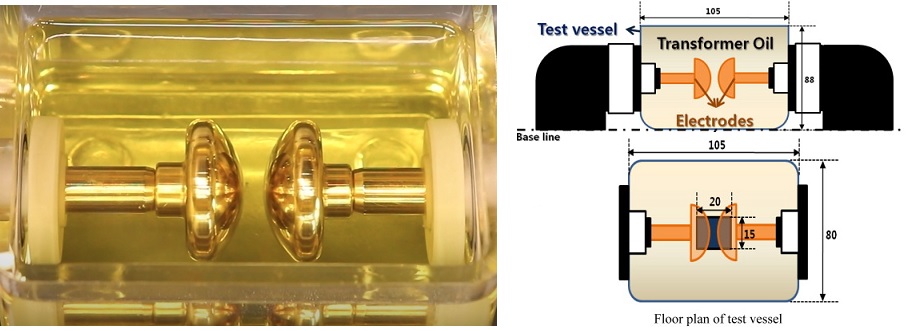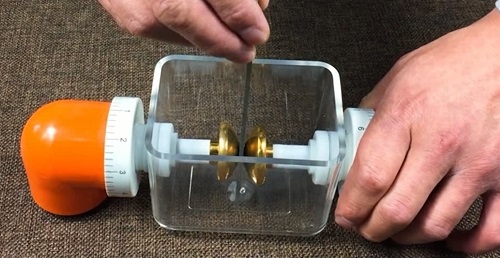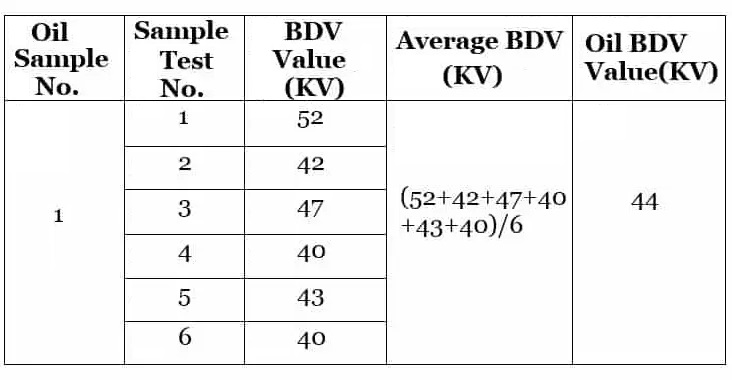Insulating oil is a type of insulating medium used in electrical equipment, primarily to provide electrical insulation and cooling. Insulating oil is mainly made from high-purity mineral oil or synthetic oil and is commonly used in transformers, capacitors, cables, and high-voltage switches.
The breakdown voltage (BDV) of insulating oil refers to the maximum voltage the oil can withstand under specific conditions (such as a specific oil temperature and electrode spacing). At this voltage, the insulating performance of the oil is breached, leading to a current passing through the oil medium and a breakdown phenomenon occurring.
Insulating oil is widely used in liquid-filled high-voltage electrical equipment, such as power transformers, distribution transformers, transformers, bushings, oil-filled circuit breakers, oil-filled cables, oil-filled capacitors, etc. Insulating oil also acts as a coolant to dissipate electrical heat in the device. Therefore, the insulating oil should have good thermal conductivity and chemical stability at high temperatures, so before the insulating oil causes internal arcing or complete equipment failure, regular oil withstand voltage testing of transformers is an important preventive measure that will help keep the high-voltage equipment running normally, otherwise it will cause transformer failure or even casualties.
ASTM D1816, ASTM D877, and IEC 60156 are some of the popular standards that specify the dielectric strength or breakdown value and breakdown procedure for testing oil samples. The test procedure is to take a sample of insulating oil from the oil drain valve of the transformer and measure its breakdown voltage, the test voltage is applied to the electrodes immersed in the insulating oil at a constant, standard slew rate (eg 2kV/sec. The test can be carried out five to six times, and the average value of these readings can be considered as the breakdown voltage of the insulating oil under test.
The dielectric breakdown or breakdown voltage of the insulating oil should not be lower than the specified value of the recommended value. If the breakdown voltage is close to the specified limit, the sample must be subjected to further diagnostic tests such as oil resistivity and dielectric dissipation factor (tan delta) tests. As per IEEE standard, it is recommended that oil breakdown voltage tests be performed twice a year.
When a voltage is applied to the insulating oil, as the voltage increases, the current through the oil increases sharply, causing it to completely lose its inherent insulating properties and become a conductor. This phenomenon is called breakdown of the insulating oil. The critical voltage value at which the insulating oil breaks down is called the breakdown voltage or dielectric breakdown. The electric field strength at this time, called the dielectric strength of the oil, indicates the ability of the insulating oil to resist the electric field. The relationship between the breakdown voltage U (kV) and the dielectric strength E (kV/cm) is:
E=U/d“
d”=The distance between the electrodes (cm).

Pure insulating oils have different breakdown mechanisms than insulating oils, which usually contain impurities.
The breakdown of the former is caused by the liberation, which can be explained by the mechanism of gas dielectric breakdown, that is, under high electric field strength, oil molecules collide and become free ions and electrons, thereby forming electron collapse. The electron collapses toward the anode, and the accumulated positive charge collects near the cathode, eventually forming a channel with high conductance, resulting in breakdown of the insulating oil.
Generally, insulating oils always contain more or less impurities, and in this case, impurities are the main cause of breakdown of insulating oil. The dielectric coefficient ε of water droplets, fibers and other mechanical impurities in oil is much larger than that of oil (ε=7 of fiber, ε=80 of water, and ε≈2.3 of transformer oil), so under the action of electric field, impurities It will be attracted to a region where the electric field strength is large, and an impurity "small bridge" is formed between the electrodes, thereby reducing the breakdown strength of the oil. If there are enough impurities, it can also constitute a "small bridge" that penetrates the gap of the electrode, and a large leakage current flows through it, causing it to generate heat, and partially boiling and vaporizing the oil and water, as a result, the breakdown is along the "air bridge."

Insulating Oil BDV Testing Procedure:
1. Clean and dry the oil test cup, standard gauge, glass rod for stirring and glass plate for covering the oil cup.2. Use a clean and dry oil sample bottle to take oil samples at the sampling port of the transformer (the sampling port should be cleaned, dried and processed), insulating oil should be cooled down to 27°C temperature before testing.

3. Rinse the oil cup three times with the sample oil. Use a gauge to adjust the distance between the electrodes of the oil cup (2.5 mm), then slowly inject the test oil into the oil cup along the stirring glass rod until it is ≥10 mm above the electrode, then cover the glass cover and let it stand still for 15 minutes to make the air bubbles in the oil overflow.

4. Then turn on the power supply of BDV tester, and increase the voltage evenly at a speed of 3~5kV/s until the oil cup electrode breaks down, and (KOF overcurrent trip) disconnect the power supply.


6. The breakdown should be repeated six times in total, normally the first time is not calculated, and the average value of the five breakdowns is taken as the final oil pressure resistance value.

7. If insulating oil BDV value is above 30 KV, transformer oil is good.
This picture shows the process and results of a breakdown voltage (BDV) test on an insulating oil sample. The test process and results are summarized as follows:

Sample test: Six independent breakdown voltage tests were conducted on Oil Sample
1. The breakdown voltage values (BDV) of each test were:
Test 1: 52 KV
Test 2: 42 KV
Test 3: 47 KV
Test 4: 40 KV
Test 5: 43 KV
Test 6: 40 KV
2.Calculate the average BDV value: average the breakdown voltage values of 6 tests. The calculation method is as follows:
Average BDV=(52+42+47+40+43+40)/ 6 = 44 KV
Result recording: The calculated average breakdown voltage value of 44 KV is used as the final breakdown voltage value (Oil BDV Value) of the insulating oil sample.
What are the Acceptance Testing Items after Transformer Installation, Commissioning and Repair?
What is the Difference Between Flash Point and Ignition Point of Transformer Oil?
Key Points to Note in Transformer Oil Breakdown Voltage (BDV) testing
High Precision Insulating Oil Tester--BDV & Tan Delta
How to Judge Transformer Fault Through Transformer Oil
Another parameter about the insulation performance of transformer oil-----Tan Delta(OTD)/Dielectric Dissipation Factor (DDF)
What is Tan δ, Or Tan Delta?
Oil Tan delta (OTD)Testing, also called Loss Angle or Dielectric Dissipation Factor (DDF) or Power Factor (PF) testing, is an electrical dielectric test on the insulating oil used to determine its quality. The test is performed at two temperatures. Information from each test and the results considered together may form the basis for making a judgment on whether it’s suitable for a transformer to continue in service and for determining when the replacement or regeneration of the transformer oil is needed.
Transformer oil is a dielectric, i.e. an insulator capable of withstanding electrical stress. When an AC voltage is applied to the medium oil, the phase difference between the passing current and the voltage at both ends is not a 90° angle, but a δ angle smaller than the 90° angle, this δ angle is called the dielectric loss angle of the oil, the dielectric loss factor of transformer oil is expressed by the tangent value of the dielectric loss angle δ.
The dielectric loss factor is a parameter to measure the degree of dielectric loss. Dielectric loss refers to the energy loss caused inside the insulating material due to the hysteresis effect of dielectric conductance and dielectric polarization under the action of an electric field.
Transformer oil dielectric loss factor tgδ value is one of the important parameters to judge the insulation state of transformer oil. Measuring the dielectric loss factor tgδ value is a traditional and very effective method for judging the insulation status of electrical equipment. The decline in insulation capacity directly reflects the increase in dielectric loss.
Under normal circumstances, when the transformer voltage level is 330KV, the dielectric loss factor tgδ value ≤0.040, when the transformer voltage level is ≥500KV, the dielectric loss factor tgδ value is ≤0.020. Defects such as moisture ingress of transformer oil, microorganisms, oxidation products, external particles, polar substances in solid insulating materials dissolved in oil, or partial discharge will all change the value of the dielectric loss factor tgδ of the transformer oil, which means that the transformer oil is insulated. The performance is reduced. Therefore, when conducting transformer oil dielectric loss tests on site, it is required that the tgδ value should not increase or decrease significantly, that is, it is required that the tgδ value should not have obvious changes in previous tests.
What is the importance of Tan Delta/Dielectric Dissipation Factor(DDF) test for transformer insulating oil?
The transformer insulating oil dielectric loss test is also a preventive test. Its purpose is to monitor the insulation performance of the transformer oil to ensure the safe operation of the transformer. Through the oil dielectric loss test, it can be found that the overall insulation is affected by moisture, aging and other distributed defects or there are defects in the insulation. Air gap discharge defects, the greater the dielectric loss factor, the higher the power loss of the oil. That is, the power loss of oil is proportional to the dielectric loss factor. In other words, the dielectric loss factor of insulating oil can clearly indicate the degree of refinement and purification of the oil.
Generally, the dielectric loss factor of normally refined and purified oil is very small, and when the temperature rises, the value of the dielectric loss factor does not increase much, and the heating and cooling curves basically coincide. However, when the degree of oil refining is not enough, or the purification is not thorough, the dielectric loss factor of the oil is large, and it increases rapidly when the temperature rises. Therefore, the dielectric loss factor is one of the quality indicators of the new insulating oil's important electrical properties.
The aging degree of insulating oil in operation can be reflected from the change of its dielectric loss factor value. When the oil has aged and there are more aging products dissolved in the oil, its dielectric loss factor will increase significantly. The dielectric loss factor value of insulating oil is of great significance to judge the quality of transformer insulation characteristics. If the dielectric loss factor of insulating oil increases, it will cause the deterioration of the overall insulation characteristics of the transformer. The dielectric loss causes heat to be generated inside the insulation. The greater the dielectric loss, the more heat will be generated inside the insulation, which in turn will increase the dielectric loss. If this continues, a breakdown will be formed at the insulation defect. affect equipment operation.
1. The GTD-61A automatic oil tan delta & oil dielectric loss tester is highly automated, allowing for the measurement of temperature rise, dielectric loss, and resistance in one go.
2. The test kit adopts medium-frequency induction heating and a PID temperature control algorithm. This heating method has several advantages, including non-contact heating between the oil cup and the heating body, uniform heating, high speed, and convenient control. As a result, the temperature is strictly controlled within the preset temperature error range.
3. The GTD-61A test kit uses advanced DSP and FFT technology to ensure data stability, accuracy, and reliability.
4. The internal standard capacitor is an SF6 inflatable three-point capacitor. The dielectric loss of this capacitor is not affected by ambient temperature and humidity, so the accuracy of the instrument is still guaranteed after long-term use.
5. The large color touch screen and English operation menu make the GTD-61A test kit easy to operate.
6. The GTD-61A test kit provides tips on opening the cover after shutting off the high voltage, short-circuiting the high and low voltage electrodes of the oil cup to eliminate any hidden safety hazards, and ensuring the safety of the operator and normal operation of the equipment.
7. The test kit has a real-time clock, allowing the test date and time to be saved, displayed, and printed with the test results. The device can also display real-time monitoring of the environment.
8. The GTD-61A can automatically store and store up to 100 sets of test data.
9. The test kit has the function of calibrating the empty electrode cup. The capacitance and dielectric loss factor of the empty electrode cup are measured to judge the conditions of the empty electrode cup. The calibration data is automatically saved to facilitate accurate calculation of relative permittivity and DC resistivity.
10. The GTD-61A has a wireless transmission function, making it easy to connect with a computer for data transmission and counter charge functions.
11. The oil can be drained off automatically without being taken out, making it convenient to clean.
1. Dielectric breakdown (BDV) (ASTM D877 & ASTM D1816, IEC 60156)
2. Tan Delta (Dielectric Dissipation Factor (DDF)/ Power factor) (ASTM D924, IEC 60247, IEC 61620, BS 5737, JIS C2101, VDE 0380-2, IS 6262)
3. Resistivity (ASTM D1169, IEC 60247, BS 5737, JIS C2101, VDE 0380-2, IS 6103)
Item
Data
Item
Data
Range
capacitance
5pF~200pF
Resolution
capacitance
0.01pF
Dielectric loss
0.00001~100
Dielectric loss
0.00001
Resistivity
2.5MOm~20TOm
Resistivity
0.001M
Accuracy
capacitance
0.5%+1pF
Tem. accuracy
±0.5℃
Dielectric loss
±(1% reading
+0.0001)
Tem. range
0~125℃
Resistivity
±10% reading
AC voltage
0~2000V
Empty cup capacitance
60±5pF
DC voltage
0~500V
Ambient Tem.
0~40℃
Ambient humidity
<80% RH
Power supply
AC220v±10%,
50±1Hz
Size(mm)
420×380×385
Power
100w
Weight
21kg

Kingrun Transformer Instrument Co.,Ltd.


More Transformer Testers from Kingrun
